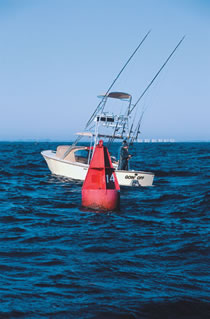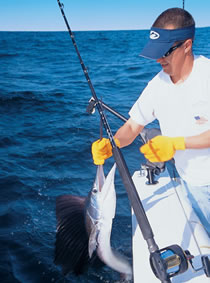May 16, 2011
By admin

A local boat stops at a shoal buoy for bait. Mate checks a mullet dredge, below.
|
Early one morning last December, Capt. Glenn Cameron spotted the kind of fish-finding sign that sailfish skippers love to see: a flock of two dozen birds diving on the horizon. What he saw next made him check his loran and GPS.
Cameron, owner and operator of the Fort Pierce charterboat Floridian, thought he might have been magically transported to the springtime waters off the Yucatan Peninsula. After all, the sight of so many hungry sailfish feeding on so much bait on the surface was not exactly common along the east coast of Florida in recent years.
But in the coming weeks, Cameron and other sailfish enthusiasts would see sailfish release numbers pile up like perhaps no other time in history. Action this hot had been reserved for exotic locales like Cancun, Guatemala and Costa Rica. But the daily dose of home-cooked double-digit releases had many a spindlebeak fan booking trips in Sailfish Alley, instead of a springtime foray to Central America.
After the last triangular red release flag was stowed for the next season, anglers, crew, observers and experts were all left wondering what caused it, and more importantly, will it happen again?
The Best Ever?
Charter captains and tournament organizers from St. Lucie, Martin and Palm Beach counties racked up record release numbers between December 2003 and February 2004. The season seemed to peak during a span of 12 days in January when four sailfish tournaments fishing from Fort Pierce, St. Lucie and Palm Beach inlets hosted over 500 anglers aboard 149 boats. Their combined efforts yielded an incredible 1,536 sailfish releases. One event employed live bait with mandatory circle hooks while the remaining three used trolled dead baits only.
During the same period, non-tournament boats from Sebastian south to Boynton Inlet capitalized on the bite. Aggressive spindlebeak activity was reported in as shallow as 40 feet of water in some spots and as deep as 300 feet.
“It was really something to see,” recalled John Jolley, president of the West Palm Beach Fishing Club and retired state fisheries scientist. “You could literally watch sailfish finning on the surface for hours as they fed on schools of sardines. It reminded me of what you see with those sails on the Pacific side of Costa Rica.”
Jolley fished his club's Silver Sailfish Derby January 8-10 and was most amazed on Jan. 9. That was the Derby's all-time greatest day, with 373 releases by 59 fishing teams live baiting with circle hooks. Chip Sheehan's crew aboard Cookie set a Derby record of 30 releases that day, trailed slightly by the 25 scored by Capt. Ray Rosher's Get Lit.
“I'll never forget what it looked like,” said Glenn Cameron, who has been in the offshore charter business for 30 years in Sebastian and Fort Pierce. “You'd see birds picking, fish cutting, then fish biting.”
On the day of the record Derby bite, Cameron was fishing the Pelican Yacht Club of Fort Pierce Invitational Billfish Tournament. In 180 to 200 feet of water east of Vero Beach, Cameron's anglers Hans Kraaz and Reid Macy sent up a respectable tournament-record 14 release flags by day's end. Their tally was matched by Frank and Mike Murray, and Chris Hodge aboard Capt. Cookie Murray's Cookie Too. The Pelican fleet of 53 boats recorded 203 releases while trolling that day.
Over the same three days of action, Jan. 8 to 10, the two tournament fleets covered an area that stretched from Sebastian to the north to Palm Beach Inlet to the south. In all, 112 fishing teams pinned 1,022 release flags to outriggers. Most of the Palm Beach boats fished between St. Lucie and Jupiter inlets while most of the Fort Pierce boats fished between Fort Pierce and Sebastian inlets.
A week later, two smaller events out of Fort Pierce and St. Lucie inlets had a combined total of 35 boats enjoy 514 releases in three days, all while trolling. These numbers only reflect actual releases, and do not account for many more fish that were hooked up and came unglued. Nor do they account for the sheer, unfathomable numbers of fish seen in the bait spreads.

Treasure Coast sails shadow bait schools. Some days they're shallow, other times they run deep.
|
Why Did All This Happen?
To bluewater specialists, winter has long been known as Florida's sailfish season. Annually, a southward migration occurs along the east coast in association with the arrival of sweeping cold fronts, falling coastal water temperatures and climbing northeasterly sea conditions. Historically, catch numbers were so strong that areas earned nicknames like “Sailfish Alley” or, as Stuart is known, “Sailfish Capital of the World.”
According to West Palm Beach Fishing Club executive director Tom Twyford, sailfish fans were lucky that the season's peak activity coincided with the heart of the tournament season.
“If these fish had swung by our coast on a Monday, we may never have known how many were out there,” Twyford joked. “There was an accumulation of factors that combined to allow us to see incredible catch numbers.”
For one, he noted, “We had assembled exceptional anglers who were very proficient at catching sailfish. Having that much collective coverage of that much water certainly contributed to a higher than average number of catches.
“There also seemed to be a really good supply of bait,” noted Miami-based Capt. Ray Rosher, who guided Get Lit anglers Kitt Toomey, Peter Miller, Charmaine Rosher and crewman Jon Cooper to a record 45 releases and the Silver Sailfish Derby win. “There were lots of schools of sardines and cigar minnows off Hobe Sound, with what seemed to be several sailfish balling each school.
“The best day of the tournament, we caught 25 and didn't win the daily award,” Rosher said. “I knew it was going to be a good day because just about everywhere we looked we saw free-jumpers. I actually had to tell my crew to stop telling me when they saw one because there were just so many sails in the air at
any given time.”
Rosher added, “It looked like Mexico out there.”
Like the west wind—often believed to decrease the chances of good sailfishing—Rosher noted that a full moon close to the tournament did little to suppress the bite.
“A lot of times it's believed that the full moon results in a slow sailfish bite as the fish go deeper or feed at night,” he observed. “Well, we sure saw the fish, which only proves one thing—you just have to be ready for anything all the time.”
Cameron doesn't even try to explain his best season in eight years, that also included three tournament victories.
“I've been here fishing my whole life and I still can't figure it out,” Cameron laughed. “Sailfish are like women—it's impossible to figure out either one.”
“We had quite a few good days during the season where we'd steam off an edge and see the birds working,” Cameron said. “We'd get up close and see so many fish cutting through the bait. It was great how many times we saw that.”
During John Jolley's career as a biologist with what is now the Florida Marine Research Institute, he was able to study sailfish movements. From 1970 to 1980, Jolley was among the first to use sonic tags in sailfish, and he compiled recreational and commercial tagging data to track the species' numbers.
According to Jolley, anglers benefited from a variety of conditions. “There was definitely some combination of large numbers of bait combined with water temperature and currents that caused the sailfish to become concentrated.
“The sheer numbers of fish we saw last year also probably represented two to three strong year classes from sailfish spawns.”
Jolley suspects that sailfish have been relatively unaffected by commercial longlining activity in the Northern Atlantic.
“Most sailfish are caught by recreational anglers and released and that conservation ethic is also helping a great deal,” he noted.
Many anglers believe that the state ban on large nets in coastal waters has helped nearshore populations of baitfish to again thrive. That may be a critical factor contributing to recent aggregations of sailfish.
“We saw sardines and greenies like never before this year and just look at how the kingfishing has come back,” said Capt. Dave Berard, who started fishing in Fort Pierce in the late 1970s. “There's probably a correlation to the amount of bait we had around here.”
Capt. Dave Chasmar, who piloted Blue By You during a record bite at the Sailfish Point Yacht Club Invitational (Jan. 16), agrees.
“For years, we ran out of St. Lucie inlet and had to turn south until we found bait and sailfish down off Hobe Sound,” he said. “It does seem like in the past few years, the bait has been more plentiful and spread out.
“Some captains I know like to fish the cleaner water and ran out to 250 feet to find it. Others, who didn't feel that clean water was as important, starting fishing shallower. It didn't seem to matter either way—everyone was catching fish.”
As to the coming season, Chasmar echoed the sentiments of many a sailfish angler: “I wonder what it's going to be like, but wouldn't it be nice to have two seasons like that back-to-back?”

